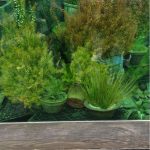Weather: Cloudy to Rainy, Location: Wuhan Botanical Garden, Guest lecturer: Xiaofan Wang
Group 5: Vicki and Zhenglin
Today started off filled with an exploration of botany! We visited the Wuhan Botanical Garden, where Dr. Xiao Fan Wang (no relation to our professor, Dr. Wang) gave us a tour, indicating many wonderful species and their unique attributes. There were submerged plants (under water), emerged plants, and semi-submerged plants.
There were so many fascinating species at the Botanical Garden! Notably, we saw many lotus species (genus Nymphaea). One species, the giant water lily (Victoria amazonica), native to shallow water bodies of South America, has evolved an incredible adaptation that gives it buoyancy – immense floating leaves with upturned edges that result in more sunlight being received and a very rapid growth rate. We also saw cycads (Genus Cycadophyta), an ancient lineage of flowering plants that has existed since the time of dinosaurs.
Introduced and invasive species were also a focal topic of discussion. For example, we saw climbing plants that grow up larger trees called Taxodium ascendens Brongn (a deciduous conifer), depriving the larger tree of sunlight. There was a path lined with sycamores (Platanus occidentalis), trees with light brown bark that tolerate pollution well, and commonly planted within cities and extensive urban areas. The desert section of the greenhouse was probably our favourite part. We saw cacti, including a species of columnar cactus that was over twice the height of Dr. Wang, aloe vera (Aloe barbadensis), and epiphytes, plants with root systems that are not embedded in substrate and can absorb moisture from the air.
One major theme of this course is identifying plant and animal taxa that can serve as ioindicators of ecosystem health, and we saw many potential examples today. Aquatic macrophytes (‘macro’=large, and ‘phytes’=plants) provide structure and correlate positively with species richness within an ecosystem. We saw many swallows as well, swooping overhead; they are aerial insectivores, and their presence implies lack of pesticides and the present of flying insects. The botanical garden really demonstrates beautifully ecosystems function and how species are adapted to different conditions and how they inter-relate, undoubtedly more important than mere aesthetics.
We saw many facets of the botanical side of ecosystems, and how the ‘mosaic’ of plants and animals create a functional wetland. Because of the language barrier for English speaking students, Dr. Bojian Chen translated –it was a very educational morning!
Afterward, we had a very lively lunch. Dr. Xiong Yang of Jianghan University (another friend and colleague of Dr. Wang) graciously hosted us. We tried dozens of dishes, including deer meat, rice wine soup, local fish, and lotus, and very light beer. It was incredibly delicious! We also had some very good discussions going, ranging from our families and our homes, to our favourite alcoholic beverages. We love how close we are all growing; living and learning together has made us all great friends.
We set out to the train station and arrived early, using the extra time to buy coffee and even more food (we are growing kids, you know). Upon boarding the fast train, we found that we had difficulty finding space for our luggage, having to settle for squeezing our bags and suitcases between rows of seats. We then settled in for the 4.5-hour train ride from Wuhan to Suzhou. On the way eastward, we saw much the same scenery as we witnessed on our fast train ride from Shanghai to Wuhan. We passed through mountains, and the fog made everything look very scenic but perhaps a bit eerie. We saw many examples of aquaculture, as well many hgh-rise residential buildings.
At Suzhou, we checked into our hotel and, to our surprise and delight, discovered that there was a cafe within its lobby, as well as a great bakery within 100 meters! It’s been another tiring but educational day.
日期::二零一八年八月十八日
天气:多云转小雨
地点:武汉植物园
客座讲师:汪小凡
制作人: Vicki and Zhenglin
今天是我们的植物学习日,早上起床后我们来到武汉植物园进行参观学习。在此期间,王小凡老师向我们介绍了我们遇到的植物种名以及它们的分类特征。在园中有很多沉水植物,挺水植物和陆生植物。
武汉植物园让我们所有的学生大开眼界,光说睡莲科(Nymphaea genus)和莲科的植物就让我们应接不暇。其中看到了一个巨大的水百合(Victoria amazonica),它的叶子进化出了一种可以接受更多阳光,加快其新陈代谢的一种表型。同时,我们还看到了一种远古的植物,名叫苏铁(Cycadophyta)。
在今天的学习过程中,我们还针对外来引进的物种和生物入侵的物种进行了深刻的讨论。首先,我们看到了一些附生植物缠绕在一颗巨大的池杉(Taxodium ascendens Brongn)之上,相互竞争阳光,这种竞争使得池杉越长越高。接着往院子的深处走,我们看到了小径两侧有一排美国梧桐(Platanus occidentalis),这些树浅棕色的树皮可以吸收空气中的污染物, 在中国城市的街道中普遍种植着这种悬铃木作为街边的行道树。由于天气原因,汪老师把我们领入到植物馆中,这里有很多美丽的仙人掌,其中一个仙人掌足足有两人高。我们还看到了芦荟,以及具有气生根的池杉(Taxodium ascendens Brongn)。
我们本节课的主题是辨别那些指示生物,水生大型生物给在植物园中生活的动物提供了良好的垂直水平的生态环境。我们在园中发现了很多燕子的存在,他们是捕食昆虫的生物,他们的存在表明了在园中杀虫剂并不是普遍使用的。事实上,植物园种养殖的植物不仅给人们提供了美的价值,更提供了它在生态系统中的意义。
时间不等人,眨眼的功夫就到了吃饭的时间,我们在武汉的一家小馆子里吃完了饭,下午踏上旅途,通过动车前往苏州。将近晚上八时,到达苏州并入住留园附近酒店
- Giant water lilies from South America 这是我们看到的睡莲
- Cycads 这些深绿色的植物是现在的活化石-苏铁
- Columnar accuse in the Wuhan botanical garden 这个是将近两人高的巨型仙人掌
- Climbing vine 这些藤本的植物附生于这些高大的乔木,不停地往高处长,与乔木竞争阳光,从而二者越长越高。
- Display of aquatic plants 这个就是我们在进门时看到的沉水植物海菜花。
- One of the myriad species of water lilies at Wuhan Botanical Garden
- One of the myriad species of water lilies at Wuhan Botanical Garden
- One of the myriad species of water lilies at Wuhan Botanical Garden
- One of the myriad species of water lilies at Wuhan Botanical Garden









Leave a Reply